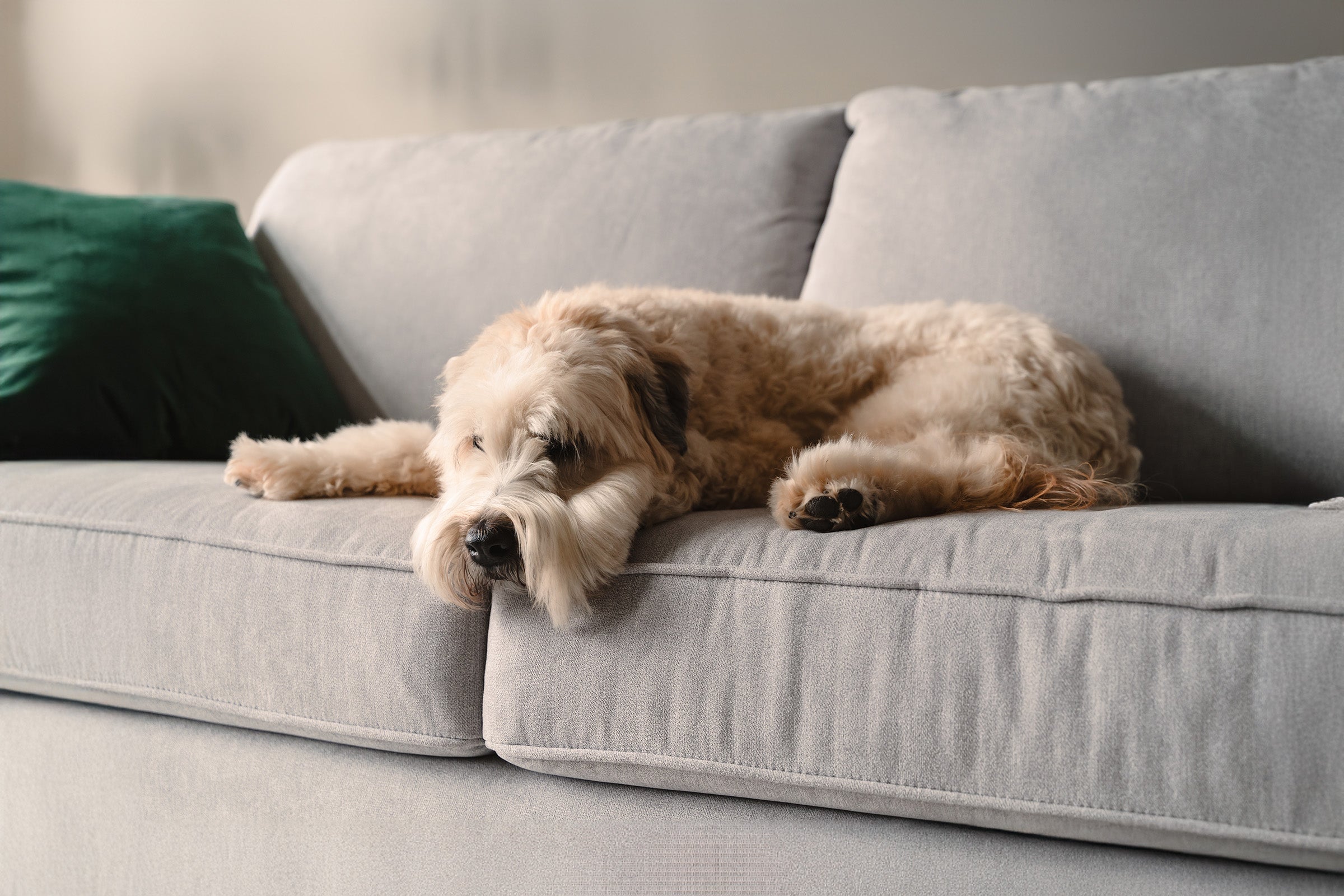As a pet parent, having a dog with separation anxiety can make running even the quickest of errands a challenge. Separation anxiety in dogs is a complex issue that can leave your pup in distress and panic when left alone. With the right approach and patience, you can work to slowly overcome your pup’s fear of being alone. Don’t worry, we’re going to break down everything you need to know about dog training for separation anxiety.
What is Separation Anxiety?
Separation anxiety is one of the most common problems in dogs, diagnosed in 20 to 40% of all dogs referred by animal behavior experts. Other research suggests that eight out of ten dogs struggle when left alone, but half don’t show obvious signs, so it’s easy to miss. Know that you’re not alone in having a dog with separation anxiety, and there is hope for change and improvement.
Separation anxiety in dogs is when your pup experiences anxiety and stress whenever they are left alone or separated from their parent. Dogs can feel overwhelming distress and anxiety when alone. Without treatment, the feelings of anxiety can become more ingrained. This can leave your pup showing signs of distress and anxiety when they think you are leaving, like when you put on your shoes or grab your bag.
While your pup is obviously in distress when you leave, separation anxiety can be very tough for pet parents as well. By understanding more about the condition, it can give you the tools to learn how to deal with separation anxiety in dogs. Then, you can start the right kind of training that will gradually improve the behavior.
Signs of Separation Anxiety
If you start to notice that your pup is looking sad or anxious as you pack your bag for the day, it could be a sign to explore the issue further. When dogs are truly dealing with separation anxiety, they typically show very real and genuine stress.
Signs of separation anxiety in dogs to watch out for include:
-
Destructive behavior like chewing on furniture, doors, or other objects.
-
Barking, howling, or whining.
-
Attempting to escape, you may notice chew marks on doors, fences, or windows.
-
Pacing, panting, or trembling.
-
Loss of interest in their food or treats
-
Having an accident indoors, despite normally being potty trained.
-
Clingy behavior and acting like they haven't seen you in a hundred years when you return.
-
Excessive drooling.
-
Self-injury and paw licking or chewing body parts.
It might start to feel like you have a furry shadow who doesn’t want to leave your side and gets very anxious at any sign that you might leave. Separation anxiety in dogs can manifest differently from mild to severe. In a mild case, your pup may pace and whine as you leave, but they settle down relatively quickly on your return. At the other end of the spectrum, severe separation anxiety can include extreme distress. Dogs may engage in destructive behavior and experience a lot of stress and discomfort.
Causes of Separation Anxiety
If you’re looking to figure out how you can help a dog with separation anxiety, understanding the potential causes and factors that contribute is a useful step.
Unfortunately, as our furry friends can’t tell us, we don’t know the exact causes of separation anxiety in dogs. However, experts believe several factors contribute to its development:
-
Lack of socialization, including their experiences early in life.
-
Changes in routine like moving home or a new addition to the family.
-
Trauma or negative experiences of being left alone in the past for a long time.
-
Frustration or boredom and a lack of environmental enrichment.
-
Shelter or rescue dogs can be more likely to experience separation anxiety.
-
Big transitions like going from working from home to full-time in the office.
Dog Separation Anxiety: Training Steps
As dogs get older, learning to cope with being left alone for a short time is part of training. Even with the best intentions, dogs can develop separation anxiety. Treatment for separation anxiety aims to help your pup feel calm and comfortable when you leave. Training uses a variety of techniques to help your pup slowly get over their fears.
Find Your Pup’s Threshold
The first step in separation anxiety training for dogs is figuring out your furry friend’s threshold. The reason it's so important to find your pup’s threshold is that if you go beyond it, it can make their anxiety worse and make it difficult to move forward with training. You want to build confidence, not overwhelm them and regress.
Here’s how to find your dog’s threshold:
-
Set up a camera so you can see what happens when you leave the house. Try using Skype or Zoom and then watch your dog’s behavior when you’re not there on your phone or tablet.
-
Start a timer at the point where your dog can’t hear you anymore.
-
Look for signs of anxiety like pacing, barking, destructive behavior, whining, or panting.
-
When these types of symptoms begin, you have found the threshold.
Let’s say you grab your keys and head out the door. You can see that after three minutes your pup starts whining and pacing; that’s your threshold.
Start Gradual Desensitization
The next stage of training is to gradually expose your dog to longer time alone, starting at the threshold. First, make sure that the environment is safe and quiet, and even leave out a favorite toy.
During training, you don’t want your pup to experience full-blown anxiety and push them to the limit. The idea is that you very gradually desensitize them to your absence bit by bit. Picture this: your pup begins to show distress and anxiety after 30 seconds. Here’s what training could look like:
-
Pick up your keys and put on your shoes, but don’t leave.
-
Then, slowly start to leave, just behind the door in the beginning.
-
Come back after a few seconds and then increase the time you’re gone.
Once your dog is feeling less anxious, you can gradually increase the time you’re gone and eventually leave the house for longer periods. Always make sure that your dog is fully relaxed before you leave, and try not to make too much fuss when you return. Don’t ignore them completely, but also don’t start a play session while training.
Work on Pre-Departure Cues
When figuring out how to reduce separation anxiety in dogs, it’s important to work on desensitizing pre-departure cues. These are things you do before you leave the house that your pup picks on and tells them they are about to be alone. Pre-departure cues include:
-
Picking up keys or purse
-
Putting on shoes or a coat
-
Grabbing a bag
-
Walking to the door
-
Opening or closing the door
-
Locking the door
-
Turning off lights
-
Driving out of the driveway
-
Specific sounds, like the garage door opening or closing
Begin to identify which cues your dog finds the most anxiety-provoking. Then, begin to include these in your training gradually, one at a time. You’re trying to teach your dog that you’re not always leaving when you pick up your keys or put on your shoes. So that over time, they don’t react so badly to these pre-departure cues. Make sure not to include too many cues at once and wait a few days at least when introducing more cues.
Keep up the Good Work
Whether it’s dog separation anxiety training or crate training, it’s not a linear process. The training journey can be up and down, but the goal isn’t a quick fix. Separation anxiety training aims to bring about gradual improvements so that eventually your pup can be left alone without panic and distress. Be patient and keep going; you’re doing an amazing job!
What about treats during training? Generally, treats are not ideal for separation anxiety training, as desensitization techniques are better for building confidence and reducing anxiety. But for other training, like teaching your dog to walk on a leash, treats can be a perfect addition to your training routine. Our healthy treats are low-calorie, so they are ideal for repeat rewarding during training.
What if Something Doesn't Go Right During Training?
Whatever happens, don’t panic and stay calm. Separation anxiety is a complex issue, so if something doesn’t go quite right, take a breath and step back. Don’t punish your dog; instead, focus on positive reinforcement and creating a calm environment. If you feel like your dog is getting elevated and panicking, try to come back before they have a full-blown anxiety attack. Be patient and take breaks from training if you feel like you need to.
How Often Should You Do Separation Anxiety Training?
As you start to make a training plan and figure out how to deal with dog separation anxiety, you need to decide how often to train. Avoid training every day and take breaks, at least one day a week. This type of training is stressful and intense, and you don’t want to push your dog beyond their limit. Stick to about 15 minutes of training, four to five times per week, and make sure to train at different times of the day. Get your household onboard and involved in training so your dog gets used to different scenarios.
We know that separation anxiety training can feel tough, but stick with it and you will start to see gradual improvements. If you need extra help or are facing a wall, don’t be afraid to ask your vet or animal behaviorist for advice and guidance.
In the meantime, we’ve got your dog’s nutritional needs covered. At Jinx, we're here to upgrade the way you care for your dog by providing holistic nutrition made with thoughtful formulation, real ingredients, and a whole lot of love.

